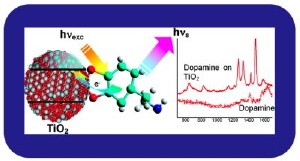Apr 24 2009
Surface-enhanced Raman scattering (SERS) spectroscopy has the potential to allow single-molecule detection sensitivity. This capability presents new approaches for studying the biophysical and biomedical properties of complex biologically relevant systems in situ. For this purpose, abundant, nontoxic, and biologically compatible materials must be used as SERS active supports.
 TiO2 nanoparticles observed by SERS. Image: Argonne National Laboratory
TiO2 nanoparticles observed by SERS. Image: Argonne National Laboratory
The CNM Nanobio Interfaces Group at the Argonne National Laboratory, together with collaborative users from the University of Queensland, Australia, and Northwestern University, report strong enhancement of selected Raman-active modes of biologically active enediol molecules adsorbed on the surface of TiO2 nanoparticles.
A charge transfer complex is necessary for the enhancement. Evidence of a unique electronic mechanism involving molecule-to-titania charge transfer is presented, which results in signicantly larger enhancement factors.
An enhancement factor of up to 1000 was observed in the solutions containing TiO2 nanoparticles and biomolecules, including the important class of neurotransmitters such as dopamine and dopac. Only selected vibrations are enhanced, indicating molecular specificity due to distinct binding and orientation of the biomolecules coupled to the TiO2 surface.
All enhanced modes are associated with the asymmetric vibrations of attached molecules that lower the symmetry of the charge transfer complex. The intensity and the energy of selected vibrations are dependent on the size and shape of nanoparticle support. Moreover, localization of the charge in quantized nanoparticles of 2 nm in size, demonstrated via blue shift of particle absorption, diminishes SERS enhancement. Importantly, the smallest concentration of adsorbed molecules shows the largest Raman enhancements — suggesting the possibility for high sensitivity of this system in the detection of biomolecules that form charge transfer complexes with metal oxide nanoparticles.
A. Musumeci, D. Gosztola, T. Schiller, N. Dimitrijevic, V. Mujica, D. Martin, and T. Rajh, "SERS of Semiconducting Nanoparticles (TiO2 Hybrid Composites)," J. Am. Chem. Soc, April 13, 2009 (http://pubs.acs.org/doi/abs/10.1021/ja808277u)